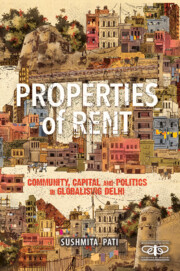Book contents
- Frontmatter
- Contents
- List of Maps and Figures
- Acknowledgements
- List of Permissions
- List of Abbreviations
- Units of Measurement
- Maps
- Introduction
- 1 Creating Values of Land: Law, Records and Kabza
- 2 From Buying Land, Owning Taxis to Becoming Landlords: The Changing Economic Landscape of Villages
- 3 Villages of the City: Ordering Spaces and Aspirations in Neoliberal Times
- 4 In the Shadows of the State: Community as a Mode of Political and Economic Organisation
- 5 Culture, Gender and Belongingness? City and the Violence of Rent
- 6 The Fringes of the Cartel: How the Marginalised Become Landlords
- 7 The Allure of Politics: The Candidates, the Cadre and the Euphoria of Elections
- Epilogue
- Glossary
- Bibliography
- Index
Epilogue
Published online by Cambridge University Press: 31 March 2022
- Frontmatter
- Contents
- List of Maps and Figures
- Acknowledgements
- List of Permissions
- List of Abbreviations
- Units of Measurement
- Maps
- Introduction
- 1 Creating Values of Land: Law, Records and Kabza
- 2 From Buying Land, Owning Taxis to Becoming Landlords: The Changing Economic Landscape of Villages
- 3 Villages of the City: Ordering Spaces and Aspirations in Neoliberal Times
- 4 In the Shadows of the State: Community as a Mode of Political and Economic Organisation
- 5 Culture, Gender and Belongingness? City and the Violence of Rent
- 6 The Fringes of the Cartel: How the Marginalised Become Landlords
- 7 The Allure of Politics: The Candidates, the Cadre and the Euphoria of Elections
- Epilogue
- Glossary
- Bibliography
- Index
Summary
After the crash of the stock market in 1929 a Great Depression engulfed western society like a grey cloud! … Where they could, people relocated from farm to city or city to farm. Seeking greener pastures like hunter-gatherers of old. But in Bronx, on Dropsie Avenue, most tenement dwellers remained holding fast to their beach-head simply because they had only just arrived from other more hostile places. They carried with them the tabernacle of a life force they hardly understood. It was now, the middle thirties….
—Will Eisner, The Contract with God TrilogyIn 1926, a Swiss architect called Hannes Meyer firmly believed he was ushering in the ‘new world’ by radically reclaiming built structures. The new-world architecture needed to be functionalist, minimalist and fiercely anti-bourgeois. Each age, after all, demands its own form. ‘It is our mission to give our new world a new shape with the means of today.’ As a Bauhaus architect, Meyer saw democratic power in art. In his famous essay titled ‘The New World’, Mayer wrote, ‘The new work of art is a work for all, not a collector's piece or the privilege of a single individual.’ The essay found immense popularity among thinkers and policymakers in the early 20th century as it exhibited the radical potential of modernist architecture. But far more than the piece, the image, Die Wohnung, or The Apartment, that accompanied the writing became iconic. Instead of predictable pictures of urban plans or even a building plan, Meyer chose to put in a picture of an eerily sparse room: a foldable cot and two foldable chairs, a minimalist shelf and a foldable stool in the corner. The only thing that could qualify as extravagant in the room was a gramophone, which sat atop the foldable stool.
The room in the picture was to become the manifesto for modern ‘minimum dwelling’: a form of functionalist urban living marked by minimalism and efficiency. Without going into an account of the unravelling of the modernist, utopian dream of heralding in a new world, it can safely be said that this modernist dream has found its way into the Global South as the stuff of nightmares.
- Type
- Chapter
- Information
- Properties of RentCommunity, Capital and Politics in Globalising Delhi, pp. 229 - 244Publisher: Cambridge University PressPrint publication year: 2022

